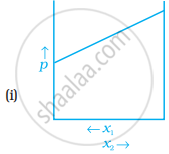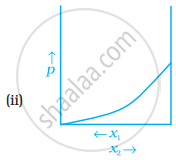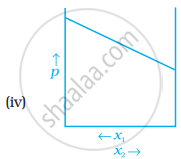Advertisements
Advertisements
प्रश्न
30 g of urea (M = 60 g mol−1) is dissolved in 846 g of water. Calculate the vapour pressure of water for this solution if vapour pressure of pure water at 298 K is 23·8 mm Hg.
उत्तर
It is given that vapour pressure of water, `p_1^0` = 23.8 mm of Hg
Weight of water taken, w1 = 846 g
Weight of urea taken, w2 = 30 g
Molecular weight of water, M1 = 18 g mol−1
Molecular weight of urea, M2 = 60 g mol−1
Now, we have to calculate vapour pressure of water in the solution. We take vapour pressure as p1.
Now, from Raoult’s law, we have:
`(p_1^0 - p_1)/p_1^0 = n_2/(n_1 - n_2)`
`=> (p_1^0 - P_1)/p_1^0 = (w_2/M_2)/(w_1/M_1 - w_2/M_2)`
`= (23.8 - p_1)/23.8 = (30/60)/(346/18 + 30/60)`
`=> (23.8 - p_1)/23.8 = 0.0105`
=> p1 = 23.5501 mm of Hg
Hence, the vapour pressure of water in the given solution is 23.5501 mm of Hg and its relative lowering is 0.0105.
APPEARS IN
संबंधित प्रश्न
State Raoult's law for the solution containing volatile components. What is the similarity between Raoult's law and Henry's law?
The vapour pressure of benzene at 30°C is 121.8 mm. By adding 15 g of non-volatile solute in 250 g of benzene, its vapour pressure is decreased to 120.2 mm. The molecular weight of solute is:
The vapour pressure of pure benzene at a certain temperature is 0.850 bar. A non-volatile, nonelectrolyte solid weighing 0.5 g is added to 39.0 g of benzene (molar mass 78 g/mol). The vapour pressure of the solution then is 0.845 bar. What is the molecular mass of the solid substance?
The solubility of a solid in a liquid is significantly affected by temperature changes.
\[\ce{Solute + Solvent -> Solution}\]
The system being in a dynamic equilibrium must follow Le-chatelier’s principle.
Considering the Le-chatelier’s principle which of the following is correct?
A solution containing 10 g per dm3 of urea (molecular mass = 60 g mol–1) is isotonic with a 5% solution of a non-volatile solute. The molecular mass of this non-volatile solute is:
The vapour pressure of a solvent decreases by 10 mm of Hg when a non-volatile solute was added to the solvent. The mole fraction of the solute in the solution is 0.2. What should be the mole fraction of the solvent if the decrease in the vapour pressure is to be 20 mm of Hg?
For a binary ideal liquid solution, the variation in total vapour pressure versus composition of solution is given by which of the curves?



Why is the vapour pressure of an aqueous solution of glucose lower than that of water?
The vapour pressure of a 5% aqueous solution of non-volatile organic substance at 373 k is 745 mm. calculated the molecular mass of the solute
The vapour pressures of pure liquids A and B are 400 and 600 mm Hg, respectively at 298 K On mixing the two liquids, the sum of their initial volumes is equal to the volume of the final mixture. The mole fraction of liquids B is 0.5 in the mixture. The vapour pressure of the final solution, the mole fractions of components A and B in vapour phase, respectively are ______.
